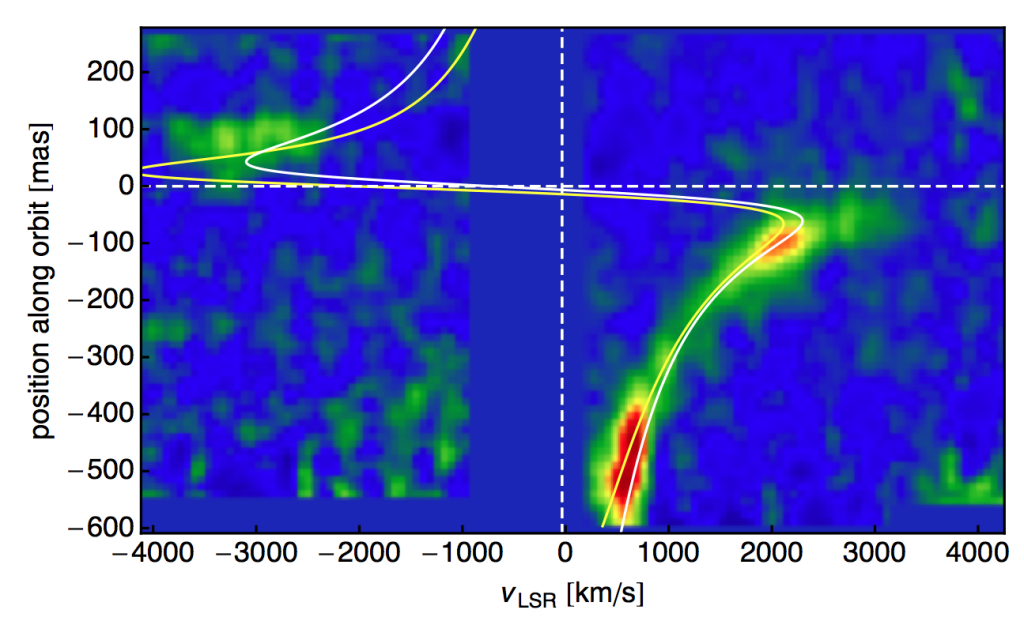- Title: Pericenter passage of the gas cloud G2 in the Galactic Center
- Authors: S. Gillessen, R. Genzel, T. K. Fritz, F. Eisenhauer, O. Pfuhl, T. Ott, M. Schartmann, A. Ballone, and A. Burkert
- First Author’s Institution: Max Planck Institute for Extraterrestrial Physics, Garching, Germany
The supermassive black hole sitting at the center of our galaxy, Sgr A*, has always been a little less exciting than the name implies. Astronomers have never observed anything fall directly into the black hole. As far as we know, it just sits there, waiting for its next meal to come along.
Only two years ago, ESO’ Very Large Telescope (VLT for short) observed a gas cloud several times the mass of the Earth speeding towards the Milky Way’s central black hole. Since then astronomers have been theorizing when and how this event will occur. Check out Susanna’s astrobite on the cloud’s discovery, Anna’s astrobite on what the cloud really is, and Ben’s astrobite on what may happen when the cloud reaches Sgr A*.
We can now put all of our theorizing to an end and let the observations begin! As of April, the head of the gas cloud has officially reached the supermassive black hole – or at least it did 1400 years ago given the distance to Sgr A*. Nonetheless, for the first time, we have observed a cloud of gas being ripped apart by the black hole itself – a process that will take a full year.
Observations
As the gas cloud is stretched the light gets harder to see, due to a process known as gravitational redshift. Electromagnetic radiation originating from a source with a strong gravitational field will be redshifted when observed in a source with a weaker gravitational field. This effect is so strong that just before the gas cloud reaches the event horizon it will no longer be visible.
The gas cloud is rapidly becoming difficult to detect, as the surface brightness has decreased drastically due to this affect. Gillessen et al. used the adaptive-optics based integral field spectrometer SINFONI onboard the VLT for a total of 1480 (24:40 hours) on-source integration time. While this data was collected in 2013, there were years of previous archived data as well, available for comparison within their analysis.
The cloud is currently at its closest approach. These observations show that it is being stretched out by the black hole’s extreme gravitational field – a process known as spaghettification. The difference between the gravitational force placed on a particle extremely close to the gas cloud versus a particle slightly further from the gas cloud is so great the entire cloud is stretched. The gas cloud is only 20 light hours from the black hole and has now been stretched over more than 15,000 Schwarzchild radii around the pericenter – closest approach – of the orbit. Figure 1 shows that spaghettification has begun!

Figure 1 – A series of position-velocity diagrams from 2004 to 2013 extracted from SINFONI data. You can easily see the evolution of tidal shear as both velocity and position have drastically increased by 2013. Credit: Gillessen et al.
Not only did Gillessen et al. note that the cloud has been tidally stretched, they were also able to measure the radial velocities of different parts of the cloud. These radial velocities appear along the line of sight, with a negative velocity or a blueshift meaning the cloud is moving towards us, and a positive velocity or redshift meaning the cloud is moving away from us.

Figure 2 – Position-velocity diagram extracted from the SINFONI data. The redshift from the head of the cloud may be seen on the left, while the blueshift from the tail of the cloud may be seen on the right. Credit: Gillessen et al.
The velocities may be seen in figure 2. The fastest component appears at a blueshift of 3000 km/s – 1% the speed of light, while the slowest component appears at a redshift of 700 km/s. The head of the cloud has swung around the black hole and is rapidly coming back towards us, while the tail is still falling inwards – an event that will last for over a year.
The origin of the gas cloud remains unclear. These new observations do contest with the gas cloud having a stellar core. It is likely that the gas originated from the stars currently orbiting Sgr A*.
Telescopes around the world are slewing their giant mirrors toward the center of the galaxy. This intense observing campaign will provide a wealth of data, revealing more about the gas cloud, and the supermassive black hole itself. Keep checking in at Astrobites. We’ll keep you posted!





Gloud = Gigantic cloud?
Great article, I really enjoyed reading it. Just one quick minor observation. When you say:
” … with a negative velocity or a blueshift meaning the cloud is moving away from us, and a positive velocity or redshift meaning the cloud is moving towards us. ”,
don’t you mean:
” … with a negative velocity or a blueshift meaning the cloud is moving towards us, and a positive velocity or redshift meaning the cloud is away from us. ”’
It was a really interesting article!
This statement:
“– or at least it did 1400 years ago given the distance to Sgr A*. ” is incorrect – the distance to Sgr A* is 27,000±1,000 ly (from wikipedia), so light takes about 27,000 years to reach us from there.
The distance to Sgr A* is 25.900 +/- 1400 ly.
So this happened more like 26K years ago 🙂